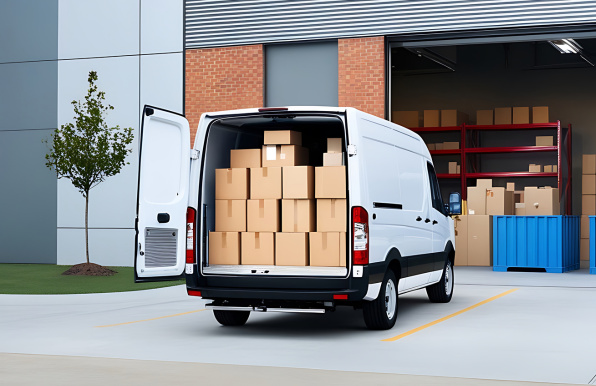- Last-Mile
What is a Last-Mile Strategy? 5 Ways to Improve Last-mile delivery strategy
To comprehend the meaning of last-mile strategy we must first understand the meaning of last-mile. The last-mile refers to the last leg of the supply chain process. It generally denotes the transportation of goods from a distribution centre to its final destination. This final destination can either be a customer’s doorstep or any retail store. Last-mile is the most critical and challenging stage of the supply chain because it touches the end consumer.
What is the Definition of Last-Mile Strategy?
Last-mile strategy refers to the tactics that are used to optimize the last-mile delivery process. At the heart of any robust last-mile strategy is a customer-centric approach. And the most important objective of any last-mile strategy is enhanced speed, efficiency and convenience. The ultimate goal of any last-mile strategy is to meet and exceed the expectations of the customers.


What is the Importance of Last-Mile Delivery?
Last-mile delivery is important for various reasons, especially in the modern age when ecommerce is booming and customer expectations are also on the rise:
1. Customer satisfaction: Since every last-mile delivery is the last touchpoint between any organization and its customer it becomes an extension of the brand image of the company. A good last-mile delivery experience can win brand loyalty. While on the other hand a broken last-mile delivery process - delays, damaged goods or poor communication - can result in customer churn and can tarnish brand image swiftly.
2. Cost efficient: The last-mile delivery accounts for nearly 53% of the total cost of shipping and that’s why companies need to take a hard look at their last-mile delivery process. By optimizing their last-mile delivery process, businesses save on transportation costs and bring down fuel expenses.
3. Better Inventory management: An optimized last-mile delivery process can enable companies to manage their inventories in an efficient way. It can help them reduce excess inventory by keeping pace with demands of the market. By maintaining correct inventory levels, companies can save on warehousing costs.
4. Focus on sustainability: Last-mile delivery is a key strategy for companies to meet their sustainability goals. By implementing environmental-friendly last-mile delivery methods, companies can reduce their carbon footprint.
5. Competitive advantage: When done well, last-mile delivery can help companies build a competitive edge over their rivals. Customers are more than happy to pay higher prices when coupled with a hassle-free delivery process.
6. Managing customer expectations: Every customer today wants an Amazon-like delivery experience. Meeting customers expectations is critical for any business to survive in this age of same-day and next-day deliveries.
7. Business growth: A good last-mile delivery process not only delivers competitive advantage but also helps companies in unlocking next-level growth. It enables businesses to tap new markets and build a new base of customers by reaching remote and underserved areas.
8. Data insights: Last-mile delivery systems are built on modern technology that not only gives customers more visibility into the orders they’ve placed but also valuable data insights for the companies. This data can be analyzed for making better operational decisions in the future.
If a business wants to succeed, it must ensure that its last-mile delivery strategy is in sync with what the customers want. And while it helps make customers happy, a smart last-mile delivery process also pushes companies towards operational efficiency, competitiveness and sustainability.


Key Considerations in an Effective Last Mile Delivery Strategy
When building a last-mile delivery strategy, companies must look at some key considerations to make their delivery process effective and efficient. A seamless last-mile strategy can help in strengthening brand loyalty, lowering operational costs and making businesses more competitive.
1. Understanding customer needs and planning: The basis of every effective last-mile strategy is customers. Therefore, businesses must understand the last-mile delivery needs of its customers and plan for it accordingly. What do customers prioritize the most? Is it speed of delivery or flexibility or proper communication? Depending on the requirements of the customers, companies can provide multiple delivery options like same-day or next-day delivery or specific-time deliveries.
2. Integrating technology: Companies can use AI and ML-powered route planning software to optimize their delivery routes and minimize empty miles, fuel costs and make their deliveries faster. Such route planning softwares takes into account weather and traffic patterns to ensure that routes are planned in the most efficient way. They are also dynamic in nature and can take into account any last-minute changes in orders or routes and revise plans to select the best possible way to deliver goods.
3. Adding visibility: Real-time tracking is the backbone of any sturdy delivery strategy. The ability to track orders is of paramount importance both for businesses and the new-age customer. More visibility into the last-mile delivery process not just helps companies deliver their goods efficiently and on-time, it has cost benefits as well. With more visibility into the last-mile process companies can take decisions proactively and avoid delivery delays, thus improving customer experience.
4. Effective communication: There is no effective delivery strategy without effective communication. Poor communication can wreak havoc for businesses in the last-mile. Imagine your delivery being delayed and not getting any proper update on the event - it is a scenario companies must avoid at all costs. Businesses must ensure that once the order is placed, the customers are sent notifications and updates to keep them informed about their deliveries.
5. Diversification of fleet: Your delivery strategy needs a diversified carrier network to be successful. Choose your fleet on the basis of the volume of goods that needs to be delivered. Select on the basis of the distance that needs to be traveled to deliver the packages. Use smart collaborations with third-party operators or leverage crowd-sourcing delivery models to diversify your fleet and expand your reach.
6. Leverage data wisely: The best part of modern day technologies is the availability of granular data. This data can be analyzed to improve the last-mile delivery operations. Companies can collect valuable insights from such data and optimize their delivery processes and enhance customer experience by identifying and removing any roadblocks in last-mile delivery.
Scalability and adaptability: An effective strategy must also integrate scalability into it. Scalability and adaptability become critical due to the fluctuations in market demand. Companies must be prepared to scale down or up based on the prevailing demand in the market.



5 Strategies to Optimize Last-mile Delivery
Customers want their deliveries fast and without any hassles. This leaves companies with no choice but to optimize their last-mile delivery. Businesses can take the below mentioned steps to optimize their last-mile delivery processes:
1. Implement route optimization: With an advanced route optimization software by your side, companies can swiftly and efficiently move thousands of goods across various distances and deliver them on schedule. These AI/ML-based softwares take into account variables like traffic, weather changes, vehicle delivery capacity, delivery time and distances to prepare the most efficient route for delivery.
2. Use modern technology: Technologies like RFID, GPS tracking and automated dispatch systems to bring in more visibility into your last-mile delivery operations. By using effective technology, businesses can weed out bottlenecks in their last-mile delivery process and not only make the delivery process smooth but also cost-efficient. With automated dispatching businesses can assign relevant orders to delivery agents based on location, delivery volume, travel distance, and fuel costs.
3. Flexibility in delivery: A sound strategy to optimize your last-mile delivery is to offer various delivery options. Giving flexibility in delivery can help businesses reduce failed delivery attempts. Companies can give options like scheduled delivery slots and secure locker pickups. Businesses can also use crowdsourced delivery networks or partner with third parties to add more flexibility and thus optimize their last-mile delivery process.
4. Bringing in real-time visibility: By bringing in real-time visibility into last-mile delivery operations companies can increase speed of delivery, cut down on costs and streamline their delivery processes. More visibility into the last leg through live tracking of delivery vehicles can enable companies to identify bottlenecks and select ideal routes for deliveries. It helps businesses provide accurate ETAs to customers and thereby enhances customer experience. With more real-time visibility, companies can easily manage delivery exceptions and reduce delivery delays.
5. Advanced Analytics: Advanced analytics and machine learning algorithms can help companies dig deeper into the intricacies of their delivery operations. Big data tools can forecast delivery volumes, identify patterns in delivery delays, and suggest improvements to further optimize the last-mile delivery process.

How FarEye can Improve Your Last-Mile Strategy
FarEye’s last-mile delivery management offers a comprehensive set of tools that your business can use to optimize, automate and personalize your last-mile delivery process.
1. AI-powered algorithms: FarEye’s AI/ML-powered route optimization software analyzes real-time data and matches them with delivery constraints to suggest the most optimal route of delivery.
2. Automatic order allocation and automatic dispatching: Both these processes help streamline last-mile delivery by intelligently assigning deliveries, tracking driver progress, and managing exceptions with ease to free up your team for strategic tasks.
3. Real-time visibility: FarEye’s last-mile delivery platform helps companies get complete visibility into their last-mile delivery network, with real-time tracking of drivers, packages, and delivery statuses.
4. Proactive communication: Keep customers informed every step of the way with automated notifications and estimated delivery times through options like chatbot-based customer support.
5. Flexible delivery options: Offer customers a variety of delivery options, including same-day, next-day, and evening deliveries, to meet their needs enabled by real-time dynamic routing and flexible delivery scheduling.
6. Customer live delivery tracking app: With FarEye customers can get branded tracking applications with electronic proof of delivery to monitor live delivery status.
7. Data-Driven decisions: Gain insights into your delivery performance with comprehensive reports and dashboards, identifying areas for improvement and use predictive modeling to forecast future delivery demand.

In Conclusion
With its focus on customer-centricity an efficient last-mile strategy involves routing and logistics optimisation, warehouse and tactical inventory management, strategic partnerships, leveraging technology correctly while ensuring that the delivery process is also sustainable. With FarEye’s last-mile delivery platform, businesses can effectively execute their last-mile strategy and deliver goods on-time and win customer loyalty.



Komal Puri is a seasoned professional in the logistics and supply chain industry. As the AVP of Marketing and a subject matter expert at FarEye, she has been instrumental in shaping the industry narrative for the past decade. Her expertise and insights have earned her numerous awards and recognition. Komal’s writings reflect her deep understanding of the industry, offering valuable insights and thought leadership.
Let's Talk to Our Experts and Optimize Your Deliveries Today!
An expert from our team will reach out within 24 hours



